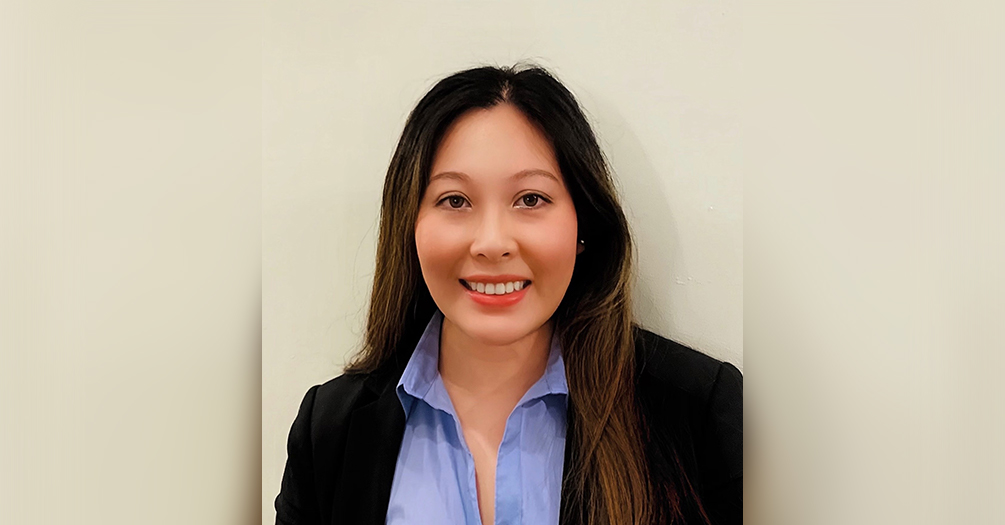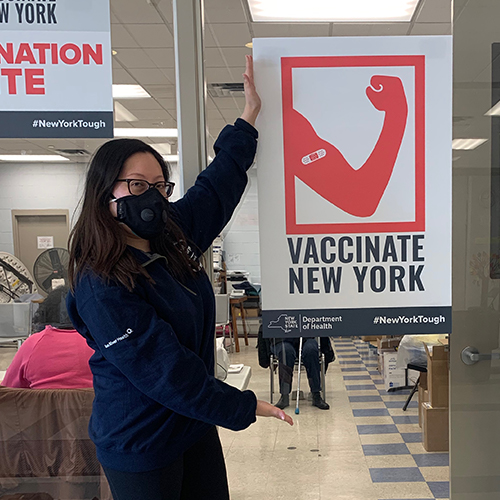Social Network: Online MPH student leverages school-wide virtual community

Heather Auto
Population and Health Sciences MPH '21; Outreach and Care Coordinator, Sun River Health
Heather Auto decided early on in her graduate program that she was going to be active in the public health community. The online Population and Health Sciences MPH student took her learning to the next level by building connections through project teams, competitions, and student groups—all while working from her home in New York as an outreach and care coordinator for Sun River Health, a National Health Corps organization, as a part of her service in the AmeriCorps program.
Over the last two years, Heather took full advantage of her online degree program, tapping into opportunities and making connections that broadened the reach of her new public health skills from New York to Michigan.
As a recent graduate, she reflects on the opportunities she hadn’t thought were possible, and the connections that endure as she moves forward as a public health professional.
I didn't think I'd make any friends. But I was wrong. It turns out I joined a flourishing and engaging online community.
What were the main activities you joined as a grad student? Did you expect to be so involved in the community when you joined your online graduate program?
I didn't expect to be involved in any way. I really thought it was going to be one of those programs I had to just get through—get my education and then leave. I didn't think I'd make any friends. But I was wrong. It turns out I joined a flourishing and engaging online community.
I sat on the board of the Public Health Student Assembly (PHSA) as the online student representative, and I participated in the Public Health Action Support Team (PHAST), the Caribbean Women’s Health Association of New York (CWHA), and the Wolverine Support Network, a student-led initiative focused on addressing and supporting mental health issues among students.
I think part of the reason I joined so many was due to a fear of missing out. I like being involved. Plus, it was a pandemic and there were very few opportunities to be social, so it gave me an excuse to connect with different people.
For example, toward the beginning of my program, I did a challenge project through the New York Academy of Science with four other classmates. We ended up working together and getting to know each other, and that's when we first started meeting outside of classes. That was sort of the catalyst. After that, we started looking for more projects that we could work on together.
Similarly, through the Wolverine Support Network, I met two friends who were Public Health students enrolled in residential programs. We kept in contact outside of our Zoom support group sessions and decided to keep doing that because we were comfortable with each other. That was very surprising. I didn't think I would have the opportunity to meet such good friends online.

Heather supports public health efforts in her home state. | Photo from Heather Auto
Joining virtually from the East Coast, what kind of work were you able to do with the Public Health Student Assembly (PHSA)?
We were able to collaborate on a lot of different projects. One of the early collaborations that I worked on was developing a gift set from the PHSA to students. Our goal was to promote wellness and community during a time when everyone had to shelter-in-place during the pandemic. Since I was remote, I couldn’t help with the physical mailing, but I put together a collection of digital puzzles to contribute. We were able to send the gift out to about 300 students.
But in general, as a representative, I’d vote on certain issues in the school community, promote new ideas, and explore different ways of collaborating. We were using our positions to get people involved and make them aware of what was happening in the middle of this pandemic.
As online students, my classmates and I signed up to do virtual work ...for everybody else, it's a setback.
As online students, my classmates and I signed up to do virtual work so that it really wasn't such a dramatic shift for us, but I imagine that for everybody else, you're on campus and then you're told to just shelter. It's a setback. So, in this group we worked on different ways that we could bring some light to a very dark situation, and help relieve some of the stress.
Shortly before you graduated, you were awarded the School’s Student Award for Diversity and Inclusion, which honors a person in the community who embodies commitment to diversity and inclusion through education, research and service. Can you tell us more about some of your work that nominators cited in honoring you with this award?
In AmeriCorps, I’m doing a lot related to trying to increase vaccination across New York state. We dispel some of the myths related to vaccine hesitancy among a population that is grappling with this historical precedent of being experimented on and who are worried about having history repeat itself. I think spending time doing outreach and care coordination in that role is an effort in increasing access for diverse populations.
Through PHAST, as well as AmeriCorps, we’ve worked on trying to de-stigmatize the idea that people who are using drugs are bad or dirty people. Within PHAST, we worked with a syringe access exchange program called Unified. We don't want people to become ill using contaminated needles. So, we work to make sure that there's a harm reduction method for people that do decide to use drugs.
Similarly, with AmeriCorps, I’m working on a medication-assisted treatment access program, where we try to reach out to clients and make sure that they're compliant with their medications. We do our best to connect with them so, if they do feel the need to use, we’re here to support them and meet them where they are without feeling like someone is judging them for relapsing.
Finally, in working with the CWHA, I was able to connect one of my Population and Health Sciences friends to that organization so, together we’ve been bringing in our skills from public health and what we've learned and trying to apply it to a real life practice situation. We've been trying to work on our data analysis and collection skills to produce this piece for the organization that they can then use to renew grants or highlight their organization in a number of ways. A lot of that work has really opened up our minds as to what diversity and inclusivity means.
In public health, [we] want to try to combat all sorts of things that could cause people harm, including racism.
In the last two years, the field and the country experienced a shift in perspective as more people began to recognize racism as a public health issue. As you reflect on your work in diversity, equity and inclusion, do you feel like that had an impact on you or changed the way you approach public health?
I think that naming racism as a public health issue and recognizing that there's an epidemic was very powerful because sometimes you think of racism as just a category instead of a cause. Having experts declare that this is an underlying trauma that affects people’s health is powerful, and it’s really something that the school has hammered home.
It made me want to explore my own identity because — coupled with everything this past year — there's been a lot of anti-Asian sentiments. It's only something I've been so aware of more recently, and not necessarily happening to me, but it's something that certain groups face. It's troubling and makes you want to galvanize and do something about it. In public health, people are very like-minded in that they want to try to combat all sorts of things that could cause people harm, including racism, so I'm glad to be part of the team that fights against it.
